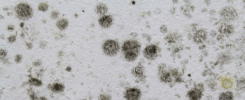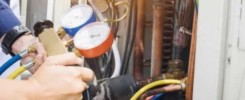There are many parts to a furnace, but the furnace’s heat exchanger is one of the most critical. It works with the burner and the blower to generate and blow heat into your home or business. The heat exchanger also separates the toxic byproducts of combustion and vents them out through your system’s flue.
A damaged heat exchanger in your gas furnace should not be ignored. A broken or leaking heat exchanger has the potential to increase carbon monoxide levels, and has the potential to pose a danger to your home or business occupants. Cracked heat exchangers are responsible for about 1500 deaths a year in the United States, and many more are poisoned by exposure to toxic gases that go unfiltered by defective heat exchangers. You cannot detect a cracked heat exchanger by visual inspection, but these signs and symptoms should give you an idea of whether you need to call us to inspect your heat exchanger.
Change in Flame Appearance
Normally, your gas furnace has a steady blue flame. If your burner has a moving yellow flame, it could be dirty or have a cracked heat exchanger. Flames that flicker, lean, dance around or change when the fan comes on, are possible signs of a cracked heat exchanger.
Cracks and Corrosion
When you can see signs of wear on external components, the internal components may be damaged as well. The normal stress on the components from expansion and contraction can cause cracks. System exposure to fumes that emit chloride or exposure to moisture from other sources can cause rust corrosion.
Soot
A properly working furnace will burn cleanly, with very little soot. Soot can collect when burners are improperly adjusted or because of a cracked heat exchanger.
Unusual odor
A faulty heat exchanger can create a strong and unpleasant odor that smells like formaldehyde. The odor can cause extreme headaches and other symptoms.
Safety Measures
Make sure your house or business is filled with the proper amount of carbon monoxide detectors. Fire detectors aren’t enough, these detectors will detect carbon monoxide in the air before it can incapacitate you.
If you have a furnace, make sure that you have it inspected annually, or every other year at a minimum.
Cracks in the heat exchanger are a serious problem and require the work of a professional as a cracked heat exchanger must be replaced. If you suspect you may be experiencing a problem with your heat exchanger, call Big Fish HVAC/R today and schedule an appointment for heating repair.
[/cherry_col]


